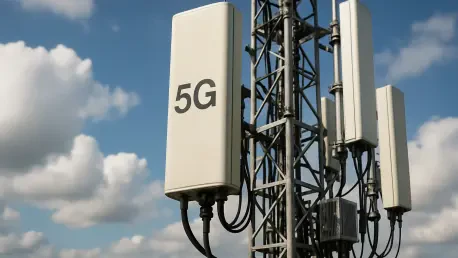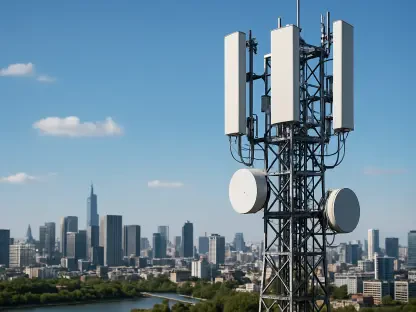In a telecommunications landscape where speed and coverage are paramount, a major player has made an unprecedented leap forward, setting a new benchmark for network expansion. Imagine a world where mobile data speeds surge by up to 80%, and fixed wireless access transforms home internet experiences almost overnight. This is the reality that a leading U.S. carrier has begun to craft with a groundbreaking deployment of newly acquired spectrum. Covering nearly 23,000 cell sites in just weeks, this initiative marks a historic milestone in the race to dominate 5G technology. The strategic acquisition of airwaves from a notable competitor has not only bolstered network capacity but also positioned the company to reach nearly two-thirds of the American population with enhanced services. This rapid rollout underscores a fierce commitment to staying ahead in a highly competitive market, promising significant improvements for millions of users across the nation.
Strategic Spectrum Acquisition and Deployment
The cornerstone of this transformative effort lies in the acquisition of a substantial $23 billion spectrum package, including 30 MHz of 3.45 GHz and 20 MHz of 600 MHz airwaves from a key industry player. This deal has enabled the company to swiftly integrate the 3.45 GHz spectrum into its existing infrastructure, achieving a record-breaking deployment pace. Unlike previous spectrum transitions that often faced delays due to prior usage, this particular band was unutilized by its former owner, simplifying the integration process. A temporary spectrum management lease further facilitated this rapid rollout, allowing activation even before regulatory approval, which is anticipated to finalize next year. The result is a significant boost in network performance, with mobile users experiencing up to 80% faster speeds and fixed wireless access customers seeing improvements of around 55%. This aggressive move highlights a clear strategy to enhance service delivery and solidify market presence through technological advancement.
Beyond the immediate impact, the long-term implications of this spectrum acquisition are equally noteworthy. While the 3.45 GHz band is already operational, the 600 MHz spectrum presents a different timeline, with deployment expected to span a couple of years due to the company’s current lack of operations in that frequency range. This phased approach ensures sustained growth in network capacity, catering to the ever-increasing demand for data-intensive applications. Historical context reveals that the 3.45 GHz band was a hotly contested asset during auctions several years ago, with major telecom players vying for dominance. The current deployment not only capitalizes on past investments but also addresses unresolved regulatory questions surrounding related frequency bands that previously hindered progress. By navigating these challenges, the company demonstrates a forward-thinking approach to leveraging spectrum assets for maximum consumer benefit and competitive advantage.
Enhancing Network Performance and Market Position
With the newly deployed spectrum, the company has reinforced its claim to network superiority, a position recently validated by independent assessments recognizing it as having the best overall network in the first half of the current year. This accolade, highlighted by the Chief Operating Officer, underscores the tangible benefits of the spectrum integration for both mobile and fixed wireless access services. Customers are already experiencing marked improvements, particularly in densely populated areas where network congestion has historically been a challenge. The focus on expanding 5G infrastructure through such strategic moves ensures that the company can meet the growing demands of streaming, gaming, and remote work applications. This enhancement is not just about speed but also about reliability, providing a seamless digital experience that sets a new standard in the industry and strengthens customer loyalty in an era of fierce competition.
Simultaneously, the company is engaging in a bold marketing campaign to assert its dominance over rivals, directly challenging competitors with claims of superior coverage and accusations of misleading advertising by others. Featuring a well-known actor, this ad initiative mirrors a competitor’s campaign, sparking significant controversy and legal action, including a cease-and-desist letter from an independent oversight body and a lawsuit filed in a Texas district court. This aggressive positioning reflects a broader strategy to not only improve technical capabilities but also shape public perception in a crowded market. By combining network advancements with assertive branding, the company aims to capture a larger share of consumer attention. This dual approach of technological innovation and competitive marketing illustrates a comprehensive effort to maintain leadership in the telecommunications sector amidst ongoing industry shifts and rivalries.
Industry Trends and Future Implications
The rapid spectrum deployment aligns with a larger trend of consolidation and strategic partnerships within the telecommunications industry. As some companies shift away from direct network operations due to regulatory scrutiny or operational challenges, others seize the opportunity to expand their infrastructure. In this case, the former spectrum owner’s pivot to a hybrid mobile network operator model, utilizing the acquiring company’s radio access network, exemplifies the evolving dynamics of collaboration over competition. This shift reflects a broader industry movement toward shared resources and efficiencies, especially as the demand for robust 5G networks continues to grow. Such arrangements suggest that future growth in the sector may increasingly rely on innovative partnerships, allowing companies to focus on core competencies while leveraging each other’s strengths to deliver enhanced services.
Looking back, the record-fast integration of the 3.45 GHz spectrum marked a pivotal moment in the company’s journey to redefine 5G capabilities. As the industry continues to evolve, the next steps involve closely monitoring the deployment of the 600 MHz spectrum and navigating ongoing regulatory landscapes to ensure sustained progress. Stakeholders should also anticipate further marketing and legal skirmishes as competition intensifies, with consumer trust becoming a critical battleground. Beyond immediate gains, exploring additional spectrum opportunities and forging strategic alliances will be essential to maintaining a competitive edge. By staying ahead of technological trends and prioritizing network reliability, the company can continue to shape the future of connectivity, ensuring that millions of users benefit from cutting-edge digital experiences in the years ahead.









